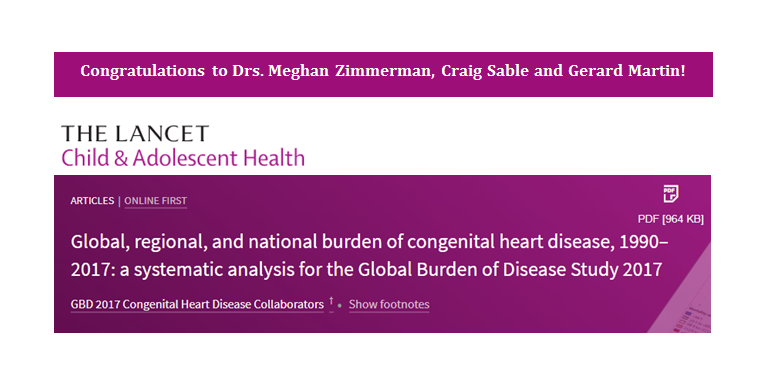
This publication on Global Burden of CHD will help change the conversation about the impact of CHD globally – highlighting the substantial loss of life to CHD in infancy around the globe. The 400+ page appendix (second link below) provides data on fatal and non-fatal outcomes for every country broken down by age group. The Global Burden of Disease study is in iterative process; this paper will allow for yearly updates of this data and all are welcome to sign up to be GBD collaborators to help inform this process.
Read the Full Publication HereSummary
Background
Previous congenital heart disease estimates came from few data sources, were geographically narrow, and did not evaluate congenital heart disease throughout the life course. Completed as part of the Global Burden of Diseases, Injuries, and Risk Factors Study 2017, this study aimed to provide comprehensive estimates of congenital heart disease mortality, prevalence, and disability by age for 195 countries and territories from 1990 to 2017.
Methods
Mortality estimates were generated for aggregate congenital heart disease and non-fatal estimates for five subcategories (single ventricle and single ventricle pathway congenital heart anomalies; severe congenital heart anomalies excluding single ventricle heart defects; critical malformations of great vessels, congenital valvular heart disease, and patent ductus arteriosus; ventricular septal defect and atrial septal defect; and other congenital heart anomalies), for 1990 through to 2017. All available global data were systematically analysed to generate congenital heart disease mortality estimates (using Cause of Death Ensemble modelling) and prevalence estimates (DisMod-MR 2·1). Systematic literature reviews of all types of congenital anomalies to capture information on prevalence, associated mortality, and long-term health outcomes on congenital heart disease informed subsequent disability estimates.
Findings
Congenital heart disease caused 261 247 deaths (95% uncertainty interval 216 567–308 159) globally in 2017, a 34·5% decline from 1990, with 180 624 deaths (146 825–214 178) being among infants (aged <1 years). Congenital heart disease mortality rates declined with increasing Socio-demographic Index (SDI); most deaths occurred in countries in the low and low-middle SDI quintiles. The prevalence rates of congenital heart disease at birth changed little temporally or by SDI, resulting in 11 998 283 (10 958 658–13 123 888) people living with congenital heart disease globally, an 18·7% increase from 1990 to 2017, and causing a total of 589 479 (287 200–973 359) years lived with disability.
Interpretation
Congenital heart disease is a large, rapidly emerging global problem in child health. Without the ability to substantially alter the prevalence of congenital heart disease, interventions and resources must be used to improve survival and quality of life. Our findings highlight the large global inequities in congenital heart disease and can serve as a starting point for policy changes to improve screening, treatment, and data collection.
Funding
Bill & Melinda Gates Foundation.





